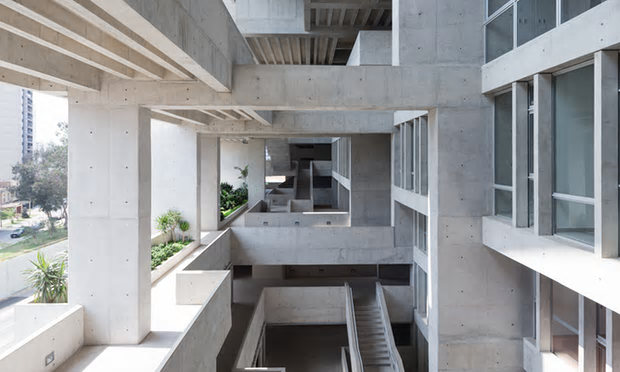by Theodore Dalrymple

In the second section of the Guardian for 16 January, there is an article about a building in Peru that has ‘just earned… the title of best new building in the world.’ As the awarding body was the Royal Institute of British Architects, it was only to be expected that the building was a complete aesthetic mess, an eyesore: for it is by awarding prizes to eyesores that the RIBA covers up its past and present crimes. And yet the building, entirely of concrete, does not look half as bad as it will look after a few years.
The architects were two Irish women. One of them said of their work, ‘We’re interested in weight. For us, the enjoyment of architecture is the sense of weight being borne down or supported, the feeling of moving with the forces of gravity. It’s a very primal need.’
I have noticed that when an artist or architect begins by saying ‘I’m interested in…’ bilge is sure to follow, as the night the day. What does it mean, that the enjoyment of architecture is the sense of weight being borne down or supported? Is architecture some kind of weightlifting competition?
Does anyone arrive in Venice or see the Taj Mahal for the first time and say, ‘Oh, what a wonderful sense of weight being borne down or supported’? And could anything be a primal need, of all things, that is to say a need that precedes all other needs?
Of course, a great building may also be a marvel of engineering: but the engineering is the servant not the master, and is used either for a utilitarian or aesthetic purpose, or both at the same time. The ironwork of Victorian stations shows this to perfection.
The gushing Guardian architecture correspondent, Oliver Wainwright, says of the two architects that, ‘drawing on Peru’s tradition of terraced landscapes, they have crafted a modern Macchu Picchu.’ From the photograph provided to accompany the article, their building is awkward, angular, without overall unity; its spaces are mean narrow, and oppressive and its proportions a mess. And this is all before the concrete, for the moment pristine, begins to deteriorate. No future tourist will come to marvel at it.
Yet it is unfortunately possible that it is ‘the best new building in the world.’ This, unfortunately, tells us more about the world than about the building. One of the problems is that the pseudo-cerebrations of architects now take precedence over taste, either their own or that of their patrons.
First published in Salisbury Review.
- Like
- Digg
- Del
- Tumblr
- VKontakte
- Buffer
- Love This
- Odnoklassniki
- Meneame
- Blogger
- Amazon
- Yahoo Mail
- Gmail
- AOL
- Newsvine
- HackerNews
- Evernote
- MySpace
- Mail.ru
- Viadeo
- Line
- Comments
- Yummly
- SMS
- Viber
- Telegram
- Subscribe
- Skype
- Facebook Messenger
- Kakao
- LiveJournal
- Yammer
- Edgar
- Fintel
- Mix
- Instapaper
- Copy Link









2 Responses
Close second was cell Block D at Parchman Farm.
I very much like Romamesque architecture which with its vaulting and pillars does give a strong sense of weight being supported. So in some cases this can be a reasonable aesthetic criteria.